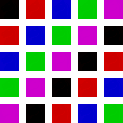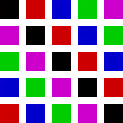
Latin Squares in Practice and in Theory II
3. Mutually Orthogonal Latin Squares (MOLS)
After the ``Euler spoiler'' examples of Bose, Parker and Shrikhande,
pairs of orthogonal latin squares were known in every size except
2 and 6. For some sizes more was known. For example, if n
is a prime, then one can construct n-1 mutually
orthogonal latin squares.
| Four MOLS
of size 5. In the first, each row is
shifted one spot to the left with respect to the row above it;
in the second, each is shifted two spots to the left, etc.
This pattern,
using the n-1 possible slopes,
gives n-1 MOLS for
any prime size n. |
What happens with other sizes? Let N(n) be
the number of MOLS that
exist of size n.
It is known that
- N(n) is at most n-1;
- for primes (see above) and powers of primes, this
upper bound can be attained.
Other numbers require special methods. The results are
very incomplete, and the problem is currently a hot one in
combinatorics. Here is a table from a recent paper by
Charles Colbourn and Jeff Dinitz, reproduced with the authors' permission. They tabulate the best known lower
bound on N(n), for n from 0 to 199.
0 1 2 3 4 5 6 7 8 9 10 11 12 13 14 15 16 17 18 19
0 1 2 3 4 1 6 7 8 2 10 5 12 3 4 15 16 3 18
20 4 5 3 22 6 24 4 26 5 28 4 30 31 5 4 5 6 36 4 5
40 7 40 5 42 5 6 4 46 7 48 6 5 5 52 5 6 7 7 5 58
60 4 60 4 6 63 7 5 66 5 6 6 70 7 72 5 5 6 6 6 78
80 9 80 8 82 6 6 6 6 7 88 6 7 6 6 6 6 7 96 6 8
100 8 100 6 102 7 7 6 106 6 108 6 6 13 112 6 7 6 8 6 6
120 7 120 6 6 6 124 6 126 127 7 6 130 6 7 6 7 7 136 6 138
140 6 7 6 10 10 7 6 7 6 148 6 150 7 8 8 7 6 156 7 6
160 9 7 6 162 6 7 6 166 7 168 6 8 6 172 6 6 14 9 6 178
180 6 180 6 6 7 9 6 10 6 8 6 190 7 192 6 7 6 196 6 198
|
| The current state of the art
in mutually orthogonal latin squares. This table gives, for n
from 0 to 199, the best known lower bound for the number N(n)
of MOLS of size n. Note that for n prime or a power
of a prime, the lower bound is the maximum, n-1. Numbers
in red are brand new or only a few years old.
For more information, consult the CRC Handbook of
Combinatorial Designs. |




